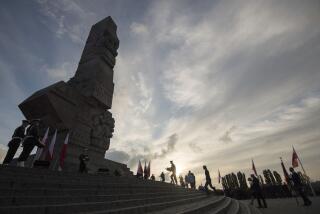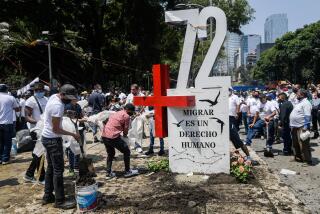Unearthed Remains Point to Systematic Killings in Bosnia
KALESIJA, Bosnia-Herzegovina — Case No. 089 wore green-soled athletic shoes. A polyester jacket covered his frame. Most of his teeth were missing. And seven high-velocity bullets had shattered his pelvis, legs and back.
His skeleton was pulled the other day from the choppy mud of a sloping, roadside mass grave, one of Bosnia’s many. Now his bones rest, with 186 other corpses and skeletons, in a refrigerated compartment inside a cavernous, bullet-riddled factory that has become a war crimes morgue.
Forensic pathologists, archeologists and anthropologists from 12 countries are attempting to piece together the circumstances of No. 089’s death, as well as those of his companions, and to document the deadliest atrocity of Europe’s deadliest conflict since World War II: the fall of Srebrenica.
Four months after the first exhumations began and precious weeks before winter will force them to stop, the investigation is beginning to produce results. A substantial, concrete case of mass homicide is being built, investigators said, and some of the first bodies--out of more than 7,000 missing Muslim men--are likely to be identified within weeks.
In one case, a simple but unique dental bridge is expected to solve the mystery of a dead man’s identity.
Srebrenica, a Muslim enclave in eastern Bosnia-Herzegovina that the West had promised to protect, was overrun by the Bosnian Serb army July 11, 1995. The victorious Bosnian Serbs separated Muslim men and boys from their fleeing and deported families; most were never seen again. Many are believed to have been buried in more than a dozen secret grave sites scattered west and north of Srebrenica in Serb-conquered Bosnia.
Autopsy reports for more than 100 victims exhumed in the past month from two of the mass graves show, in the words of one investigator, a monotonous redundancy of wounds that indicates the men were not killed in combat, as the Bosnian Serbs have claimed. Rather, the young men appear to have been lined up and shot, then covered with dirt where they fell.
Almost all wore civilian clothes--plaid shirts, bluejeans, lightweight jackets, athletic shoes. Several were found with their hands tied behind their backs.
“We always look for obvious evidence of execution-style killings,” said Robert H. Kirschner, a prominent expert in mass-grave exploration and one of the leaders of the Bosnia effort. “Hands tied behind the back is sort of the smoking gun. You find that, you’ve reached the moment of truth.”
Other key evidence is the pattern of wounds, Kirschner said. In combat, there are various wounds, from shrapnel as well as gunshots; they occur in a variety of places on the body. But at Cerska, the makeshift grave that has produced, thus far, the largest number of bodies, most of the men had been hit at least half a dozen times in almost identical places by high-velocity gunfire--across the chest, pelvis and legs--according to autopsy reports viewed by The Times. Some bore additional, single shots to the head.
“This does not leave much question about what happened,” Kirschner said. “We can tell where and how they were killed. Who is responsible, of course, is someone else’s job.”
Bullet casings found in the area of the graves have shed light on the type of weapons used. This may help prove who is responsible. The evidence is expected to be part of the case against Bosnian Serb army commander Gen. Ratko Mladic and political leader Radovan Karadzic at the United Nations war crimes tribunal at The Hague. The tribunal has indicted both men on charges of genocide as a result of the Srebrenica massacres.
Mladic and Karadzic continue to live freely in Serb-held Bosnia, despite the presence of almost 60,000 NATO-led peacekeeping troops and despite international arrest warrants issued by The Hague. Mladic lives a dozen miles from one of the exhumations.
The mass graves were first pinpointed last year by U.S. spy satellites. In April, teams from the war crimes tribunal, led by pathologist William Haglund of Seattle, began exploratory digs to confirm the presence of bodies. Full exhumations began in July at Cerska, where 154 bodies were found, followed by two sites at Nova Kasaba, where 33 more bodies were retrieved.
Several other sites are to be excavated, all under the watch of North Atlantic Treaty Organization troops and private guards.
The investigation has been delayed by difficulties in mine clearing. A Norwegian firm with mine-sniffing dogs began the job but left after a few weeks for another project, in Mozambique. An expensive British firm, without dogs, was this week scouring the next site, a field known as Lazete.
Haglund and Kirschner, a former medical examiner in Cook County, Ill., are sponsored by the Boston-based Physicians for Human Rights; they, with other members of the team, have exhumed mass graves in, among other countries, El Salvador, Guatemala, Argentina and Rwanda.
Bosnia, team members say, is different. It is vastly more complicated politically and logistically, they say. The war here is recent and has the potential to reignite at any time. But in contrast with the circumstances in Latin America, where the most notorious mass graves could not be examined until years after the killings, the relative newness of the Bosnian corpses is yielding a wealth of evidence.
The top layers of bodies, as is typical in mass graves, have been predominantly skeletal. But underneath, where the soil is more moist and there is less insect or predator activity, the bodies have been more complete.
Exhumation of decomposing bodies, while more stressful because of the overpowering stench and the gruesome sight of decaying flesh, lets investigators better reconstruct a crime. Tissue holds shattered bones together, Kirschner explained, showing more clearly the speed, force and impact of the ammunition.
“We have to work fast . . . to avoid the mummification process, to preserve the tissue and keep it from drying out,” said David del Pino, a Chilean anthropologist and team member. “If they are allowed to mummify, the pathologist loses a lot of information in the autopsy.”
Working with cadavers, as opposed to skeletons, also gives a more vivid picture of how the corpses were disposed of. Investigators at Cerska, especially, have noted the chaotic way in which bodies were piled atop each other.
“It was not a burial but a matter of depositing and covering,” Del Pino said. “You can see the desire of elimination. There is an extreme disregard for the bodies.”
The remains from Cerska and Nova Kasaba were bagged and transported to the factory here in Kalesija, about 15 miles southeast of Tuzla and just inside territory controlled by the Muslim-led Bosnian government. At the factory, shielded behind large plastic sheets, workers wash and catalog clothing and all personal effects; they then conduct autopsies at a rate of about four a day.
Because some team members hail from countries like Guatemala, where they saw military men slaughter and get away with it, the pursuit of justice is a strong motivation for them.
“Only with justice can there be liberation from the terror,” said Fernando Moscoso, a Guatemalan archeologist who specializes in Mayan cultures and is co-founder of his country’s forensic anthropological team. “Even if the justice is not complete, [our work] at least allows recognition of how these people died.”
Seeking justice in court is one thing; the perhaps equally difficult task of identifying individual bodies--not part of the tribunal’s specific mission--is another. Increasingly vociferous and political, the mostly female survivors of Srebrenica are demanding answers. While they understand the need for meticulous science, they do not understand the slow pace of exhumations. Many harbor desperate hope that their husbands and sons are somehow still alive, in forced-labor camps or clandestine prisons.
The forensic team is entering reams of autopsy information into a computer, which will be cross-checked with an antemortem database being compiled by Physicians for Human Rights. The identification project is conducting extensive interviews with survivors. But the database for Srebrenica victims is unlikely to be completed for 10 months, said Wisconsin doctor Laurie Vollen, the project director.
“It is very, very painful for everybody involved in the process,” she said of the interviews, which began this month. Surveyors ask 270 questions, from what the missing person was last seen wearing to whether he had any broken bones. A section on “deformities caused by injury” was added after it became clear that many of the missing had been injured in shellings.
As for Case No. 089, he was fairly typical of those in the Cerska grave. Reading his bones, investigators calculated that he was almost 6 feet tall and between the ages of 26 and 32. He had cigarettes and a lighter in his pocket; he wore a watch.
A small number of men carried identification cards; investigators expect to tentatively identify them soon. For one man, a contraption of metal and teeth, which he wore as a dental bridge, may be the clue.
Identification, while limited, is vital to families and has some bearing on the legal case. But of overriding importance to the investigators is history and truth.
“What continues to be interesting to me is how the perpetrators were totally unafraid of any consequence of their actions,” Kirschner said. “They believed they would never be held accountable. . . . This is why you have to do these exhumations and autopsies. It is the only way to preserve an accurate record.”
More to Read
Sign up for Essential California
The most important California stories and recommendations in your inbox every morning.
You may occasionally receive promotional content from the Los Angeles Times.











